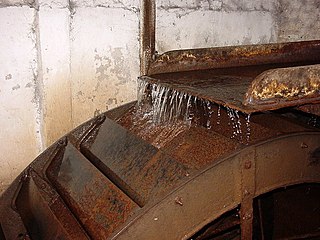History
Tregwynt woollen mill (Melin Tregwynt) lies in an isolated valley on the coast of Pembrokeshire. It is about 0.75 miles (1.21 km) from the Pembrokeshire Coast Path. The hipped and whitewashed rubble stone building has the date of July 1819 on a roof truss. It was originally a corn mill, and was converted to a woollen mill later in the 19th century. The mill was part of the Tregwynt estate. On the 1841 Tithe Map, it was called Dyffryn Bach, owned by G. J. Harries and occupied by David Evans.
The local farmers would sell their fleeces to the mill, which would wash, card, comb, and spin the wool into yarn and then weave it into blankets. The mill was powered by water from the local stream. In an unusual design, the water wheel is inside the building. The large iron overshot wheel probably dates to the later part of the 19th century. The water wheel drove hammers that beat the woven cloth to clean and soften it. Later the water wheel drove leather belts that powered the carding engines and looms. This equipment has been preserved in the old section of the mill.
The present owner's grandfather bought the mill for £760 in May 1912 and operated it with his son. During World War II the mill devoted most of its capacity to making knitting wool, which was not rationed. In the 1950s the owners opened a shop at the mill and in St Davids and Fishguard, and started to develop Melin Tregwynt as a brand. The business thrived in the 1960s and 1970s and survived the recession in the 1980s that forced many other Welsh mills to close. The founder's grandson entered the business and started to develop foreign markets.
Recent years
As of 1997 the mill was weaving 2 miles (3.2 km) of cloth each month. Melin Tregwynt now outsources some processes, including carding and spinning. The mill's water wheel still functions but is no longer used to power the machinery. The 2008 Guinness Book of Records noted that the mill had woven the world's largest picnic blanket for Waitrose. In 2012, the mill celebrated 100 years as a family business, now weaving for a global market. The looms are still manually warped, the knots are tied by hand and the blankets are finished by hand. Melin Tregwynt operates a cafe at the mill as well as the shop.
In September 2012, Melin Tregwynt was featured at Heal's in London during the London Design Festival. In 2012 the Welsh fashion designer Jayne Pierson created a line of bespoke women's wear for Melin Tregwynt. The mill featured in a BBC Two Wales Made in Wales episode in December 2012. The mill's products have been featured on various TV shows including Big Brother and Doctor Who. In 2013, the mill exhibited at the Milan Furniture Fair. In 2015, a design by Melin Tregwynt was used as the pattern for a dance choreographed by Angharad Harrop to be performed in the National Theatre Wales and Theatr Genedlaethol Cymru.
As of 2016, the mill employed about 30 people. It is a Grade II listed building. [17]
Gear shaft
Loom
Water wheel
Racks of wool

The spinning jenny is a multi-spindle spinning frame, and was one of the key developments in the industrialisation of textile manufacturing during the early Industrial Revolution. It was invented in 1764 or 1765 by James Hargreaves in Stan hill, Oswaldtwistle, Lancashire in England.

Flannel is a soft woven fabric, of varying fineness. Flannel was originally made from carded wool or worsted yarn, but is now often made from either wool, cotton, or synthetic fiber. Flannel is commonly used to make tartan clothing, blankets, bed sheets, and sleepwear.

The spinning mule is a machine used to spin cotton and other fibres. They were used extensively from the late 18th to the early 20th century in the mills of Lancashire and elsewhere. Mules were worked in pairs by a minder, with the help of two boys: the little piecer and the big or side piecer. The carriage carried up to 1,320 spindles and could be 150 feet (46 m) long, and would move forward and back a distance of 5 feet (1.5 m) four times a minute.

Spinning is an ancient textile art in which plant, animal or synthetic fibres are drawn out and twisted together to form yarn. For thousands of years, fibre was spun by hand using simple tools, the spindle and distaff. It was only with the invention of the spinning wheel in the Islamic world circa 1030, and its subsequent introduction to China, India and Europe in the High Middle Ages, that the output of individual spinners dramatically increased. Mass production later arose in the 18th century with the beginnings of the Industrial Revolution. Hand-spinning remains a popular handicraft.

The National Wool Museum, located in Drefach Felindre, Llandysul, Carmarthenshire, is part of Amgueddfa Cymru – Museum Wales.
Textile manufacturing is one of the oldest human activities. The oldest known textiles date back to about 5000 B.C. In order to make textiles, the first requirement is a source of fibre from which a yarn can be made, primarily by spinning. The yarn is processed by knitting or weaving to create cloth. The machine used for weaving is the loom. Cloth is finished by what are described as wet process to become fabric. The fabric may be dyed, printed or decorated by embroidering with coloured yarns.

Dre-fach Felindre is a village in Carmarthenshire, West Wales. It is located four miles south-east of Newcastle Emlyn. It lies at the confluence of three fast-flowing streams, the Nant Bargod, Nant Esgair and Nant Brân, where their steep-sided valleys open out into the Teifi Valley. In the 19th and early 20th century it was an important centre for the woollen industry and was given the epithet, "the Huddersfield of Wales". As the population increased, the villages of Dre-fach and Felindre extended and merged to form the present community.

Bradford Industrial Museum, established 1974 in Moorside Mills, Eccleshill, Bradford, United Kingdom, specializes in relics of local industry, especially printing and textile machinery, kept in working condition for regular demonstrations to the public. There is a Horse Emporium in the old canteen block plus a shop in the mill, and entry is free of charge.

Jayne Pierson is a Welsh fashion designer. She launched her début collection with On|Off at London Fashion Week in September 2009. She has designed for Alexander McQueen and Vivienne Westwood. Her speciality is designing fashions for artists and actors.

Pencaer is a community which covers an area of dispersed settlement in Pembrokeshire, Wales, on the peninsula of Pen Caer and comprises the village of Llanwnda and the smaller settlements of Granston, Llangloffan, St Nicholas (Tremarchog) and Trefasser. The population of the community taken at the 2011 census was 474.

Tregwynt Mansion is a house in the parish of Granston in Pembrokeshire, Wales. The Tregwynt Hoard was found during renovations in 1996.
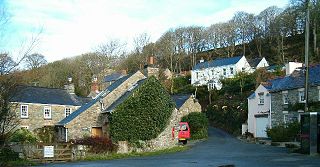
Middle Mill is a small settlement on the River Solva in the parish of Whitchurch, Pembrokeshire, Wales, approximately 1 mile upstream from the coastal village of Solva.
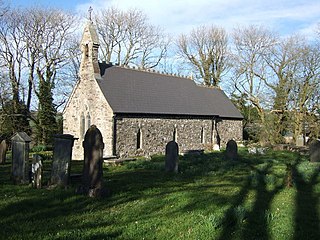
Granston is a hamlet and parish in Pembrokeshire, Wales. The parish was in the Hundred of Dewisland and includes the settlements of Llangloffan and Tregwynt, with Tregwynt woollen mill. Granston is in the community of Pencaer.

The woollen industry in Wales was at times the country's most important industry, though it often struggled to compete with the better-funded woollen mills in the north of England, and almost disappeared during the 20th century. There is continued demand for quality Welsh woollen products.
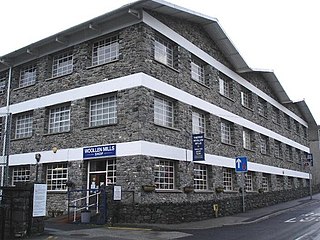
Trefriw Woollen Mills is a woollen mill in the village of Trefriw, Conwy, in northern Wales, that has been operating since around 1825.
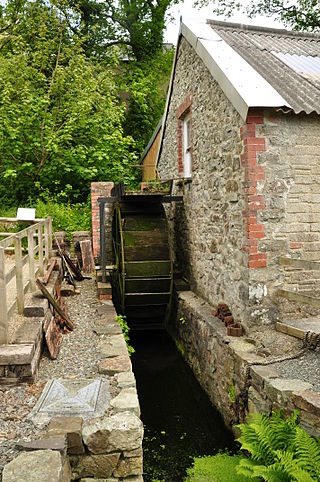
Solva Woollen Mill is a woollen mill in the village of Middle Mill, about one mile from Solva, Pembrokeshire, Wales, that has been in operation since 1907.

Rock Mill Llandysul, in Capel Dewi, Llandysul, Ceredigion, is the last woollen mill in Wales to be powered by a water wheel.

Cambrian Woollen Mill, just north of Llanwrtyd Wells, Powys, is one of the few remaining operational woollen mills in Wales. It is known for its line of Welsh tartans. The building dates to 1820.

Kerry Woollen Mills are historic wool mills based just off the Ring of Kerry.

Cwmhiraeth is a hamlet in Carmarthenshire, Wales, contained in the Dre-fach Felindre district. While the name has no exact meaning in English, it can be roughly translated to "valley of longing". Cwmhiraeth used to be a source of activity for the textile industry, but has since declined.




